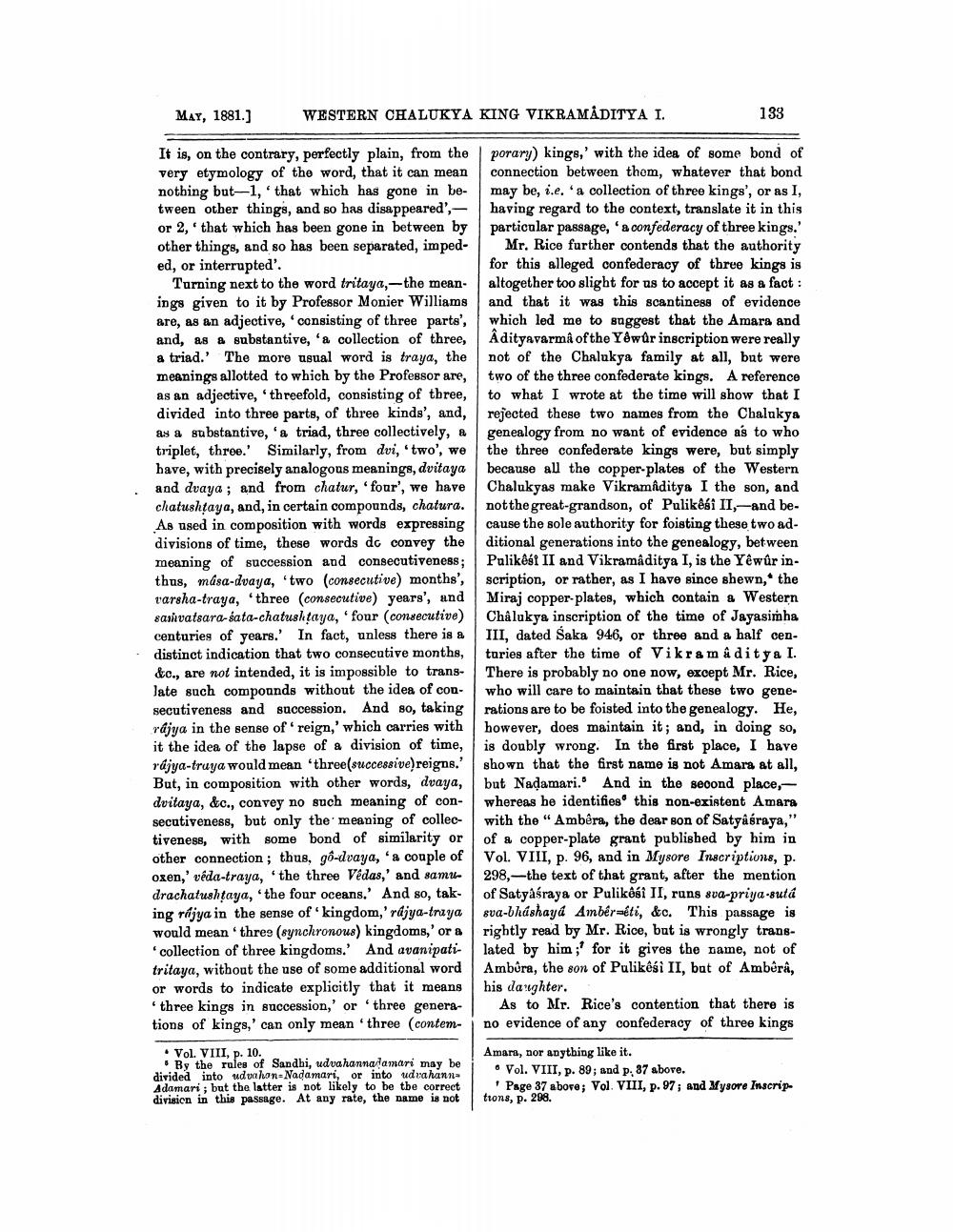________________
WESTERN CHALUKYA KING VIKRAMADITYA I.
MAY, 1881.]
It is, on the contrary, perfectly plain, from the very etymology of the word, that it can mean nothing but-1, that which has gone in between other things, and so has disappeared', or 2, that which has been gone in between by other things, and so has been separated, impeded, or interrupted'.
Turning next to the word tritaya,—the meanings given to it by Professor Monier Williams are, as an adjective, consisting of three parts', and, as a substantive, 'a collection of three, a triad.' The more usual word is traya, the meanings allotted to which by the Professor are, as an adjective, threefold, consisting of three, divided into three parts, of three kinds', and, as a substantive, 'a triad, three collectively, a triplet, three. Similarly, from dvi, 'two', we have, with precisely analogous meanings, dvitaya and dvaya; and from chatur, 'four', we have chatushṭaya, and, in certain compounds, chatura. As used in composition with words expressing divisions of time, these words do convey the meaning of succession and consecutiveness; thus, masa-dvaya, 'two (consecutive) months', varsha-traya, 'three (consecutive) years', and samvatsara-sata-chatushṭaya, 'four (consecutive) centuries of years.' In fact, unless there is a distinct indication that two consecutive months, &c., are not intended, it is impossible to translate such compounds without the idea of consecutiveness and succession. And so, taking rajya in the sense of reign,' which carries with it the idea of the lapse of a division of time, rajya-truya would mean 'three(successive) reigns.' But, in composition with other words, dvaya, dvitaya, &c., convey no such meaning of consecutiveness, but only the meaning of collectiveness, with some bond of similarity or other connection; thus, go-dvaya, a couple of oxen,' vêda-traya, 'the three Védas,' and samudrachatushṭaya, the four oceans.' And so, taking rajya in the sense of 'kingdom,' rajya-traya would mean three (synchronous) kingdoms,' or a 'collection of three kingdoms.' And avanipatitritaya, without the use of some additional word or words to indicate explicitly that it means 'three kings in succession,' or 'three generations of kings,' can only mean 'three (contem
Vol. VIII, p. 10.
By the rules of Sandhi, udvahanna amari may be divided into udvahon-Nadamari, or into udvahannAdamari; but the latter is not likely to be the correct division in this passage. At any rate, the name is not
133
porary) kings,' with the idea of some bond of connection between them, whatever that bond may be, i.e. a collection of three kings', or as I, having regard to the context, translate it in this particular passage, 'a confederacy of three kings.' Mr. Rice further contends that the authority for this alleged confederacy of three kings is altogether too slight for us to accept it as a fact: and that it was this scantiness of evidence which led me to suggest that the Amara and Adityavarmâ of the Yêwûr inscription were really not of the Chalukya family at all, but were two of the three confederate kings. A reference to what I wrote at the time will show that I rejected these two names from the Chalukya genealogy from no want of evidence as to who the three confederate kings were, but simply because all the copper-plates of the Western Chalukyas make Vikramaditya I the son, and not the great-grandson, of Pulikêsî II, and because the sole authority for foisting these two additional generations into the genealogy, between Pulikêst II and Vikramaditya I, is the Yêwûr inscription, or rather, as I have since shewn,* the Miraj copper plates, which contain a Western Châlukya inscription of the time of Jayasimha III, dated Saka 946, or three and a half centuries after the time of Vikramaditya I. There is probably no one now, except Mr. Rice, who will care to maintain that these two generations are to be foisted into the genealogy. He, however, does maintain it; and, in doing so, is doubly wrong. In the first place, I have shown that the first name is not Amara at all, but Naḍamari. And in the second place,whereas he identifies this non-existent Amara with the "Ambêra, the dear son of Satyâśraya," of a copper-plate grant published by him in Vol. VIII, p. 96, and in Mysore Inscriptions, p. 298,-the text of that grant, after the mention of Satyasraya or Pulikêsî II, runs sva-priya-sutá sva-bhashayá Ambér-éti, &c. This passage is rightly read by Mr. Rice, but is wrongly translated by him; for it gives the name, not of Ambura, the son of Pulikêśi II, but of Amberâ, his daughter.
As to Mr. Rice's contention that there is no evidence of any confederacy of three kings
Amara, nor anything like it.
Vol. VIII, p. 89; and p. 37 above.
'Page 37 above; Vol. VIII, p. 97; and Mysore Inscriptions, p. 298.




